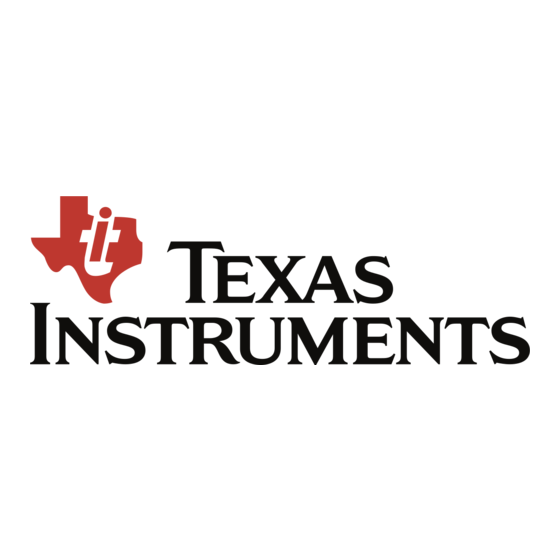Summary of Contents for Texas Instruments BoosterPack BOOSTXL-RS232
- Page 1 BOOSTXL-RS232 BoosterPack™ Hardware User's Guide Literature Number: SLLU250 November 2016...
-
Page 2: Table Of Contents
Forced Off ........................Invalid ..................Interfacing with External Hardware ......................Additional Information ......................Design Files ....................Hardware Change Log ........................ Schematic ......................PCB Layout Table of Contents SLLU250 – November 2016 Submit Documentation Feedback Copyright © 2016, Texas Instruments Incorporated... - Page 3 List of Tables ................RS-232 Female DB9 Connector Pin Summary ......................Driver Functions ......................Receiver Functions ......................INVALID Status ..................Description of Hardware Changes SLLU250 – November 2016 List of Figures Submit Documentation Feedback Copyright © 2016, Texas Instruments Incorporated...
-
Page 4: Trademarks
User's Guide SLLU250 – November 2016 BOOSTXL-RS232 BoosterPack™ Hardware Trademarks BoosterPack, LaunchPad are trademarks of Texas Instruments. All other trademarks are the property of their respective owners. Introduction Overview The RS232 BoosterPack provides the opportunity to communicate to and from a TI LaunchPad™ using the RS232 serial protocol. -
Page 5: Hardware Description
RTS1 TRS3122E J9 Header for RS232 FORCEON, LP2985-18 LDO Transceiver FORCEOFF, & & J12 Header for INVALID Selects VCC Select Figure 4. BOOSTXL-RS232 Overview SLLU250 – November 2016 BOOSTXL-RS232 BoosterPack™ Hardware Submit Documentation Feedback Copyright © 2016, Texas Instruments Incorporated... -
Page 6: Block Diagram
CTS1 GPIO Interface FORCEON GPIO 6-Pin Functional GPIO Mode/Invalid FORCEOFF Select GPIO INVALID Copyright © 2016, Texas Instruments Incorporated Figure 5. BOOSTXL-RS232 Block Diagram BOOSTXL-RS232 BoosterPack™ Hardware SLLU250 – November 2016 Submit Documentation Feedback Copyright © 2016, Texas Instruments Incorporated... -
Page 7: Db9 Connector
Shorted to pin 6 (unused flow control line) Shorted to pin 4 (unused flow control line) Request to Send 1 (RTS1) Clear to Send 1 (CTS1) SLLU250 – November 2016 BOOSTXL-RS232 BoosterPack™ Hardware Submit Documentation Feedback Copyright © 2016, Texas Instruments Incorporated... -
Page 8: Header Descriptions
FORCEON and FORCEOFF. NOTE: If FORCEON and FORCEOFF are not intended to be controlled, then remove the jumpers discussed. BOOSTXL-RS232 BoosterPack™ Hardware SLLU250 – November 2016 Submit Documentation Feedback Copyright © 2016, Texas Instruments Incorporated... -
Page 9: Header J9
LaunchPad that operates at 1.8-V logic levels. Otherwise TI recommends leaving the jumper across pins 1 and 2 of J12. Figure 9. Supply Select SLLU250 – November 2016 BOOSTXL-RS232 BoosterPack™ Hardware Submit Documentation Feedback Copyright © 2016, Texas Instruments Incorporated... -
Page 10: Led Description
The RTS1 green LED will be on when a request-to-send signal is raised and the CTS1 green LED will be on when the clear-to-send signal is raised. Otherwise, the red LEDs will be on. Figure 10. RS232 LEDs BOOSTXL-RS232 BoosterPack™ Hardware SLLU250 – November 2016 Submit Documentation Feedback Copyright © 2016, Texas Instruments Incorporated... -
Page 11: Functional Modes
H = high level, L = low level, X = irrelevant, Z = high impedance (off), Open = input disconnected or connected driver off SLLU250 – November 2016 BOOSTXL-RS232 BoosterPack™ Hardware Submit Documentation Feedback Copyright © 2016, Texas Instruments Incorporated... -
Page 12: Invalid
H = high level, L = low level, X = irrelevant, Z = high impedance (off), Open = input disconnected or connected driver off BOOSTXL-RS232 BoosterPack™ Hardware SLLU250 – November 2016 Submit Documentation Feedback Copyright © 2016, Texas Instruments Incorporated... -
Page 13: Interfacing With External Hardware
(2) * these pins are not required for BoosterPack operation. (3) ~ these pins are not required to be used but are recommended Figure 11. Interfacing With LaunchPad SLLU250 – November 2016 BOOSTXL-RS232 BoosterPack™ Hardware Submit Documentation Feedback Copyright © 2016, Texas Instruments Incorporated... -
Page 14: Additional Information
Additional Information Design Files All design files including schematics, layout, bill of materials (BOM), Gerber files, and documentation are available in the Texas Instruments Resource Explorer: dev.ti.com/tirex The schematic is shown in Section 6.3, the top layer and bottom layer PCB layouts are illustrated in... -
Page 15: Pcb Layout
BOOSTXL-RS232. Figure 14 shows the bottom layer routing of the BOOSTXL-RS232. Figure 14. Bottom Layer Routing Figure 13. Top Layer Routing SLLU250 – November 2016 BOOSTXL-RS232 BoosterPack™ Hardware Submit Documentation Feedback Copyright © 2016, Texas Instruments Incorporated... - Page 16 STANDARD TERMS AND CONDITIONS FOR EVALUATION MODULES Delivery: TI delivers TI evaluation boards, kits, or modules, including demonstration software, components, and/or documentation which may be provided together or separately (collectively, an “EVM” or “EVMs”) to the User (“User”) in accordance with the terms and conditions set forth herein.
- Page 17 FCC Interference Statement for Class B EVM devices NOTE: This equipment has been tested and found to comply with the limits for a Class B digital device, pursuant to part 15 of the FCC Rules. These limits are designed to provide reasonable protection against harmful interference in a residential installation.
- Page 18 【無線電波を送信する製品の開発キットをお使いになる際の注意事項】 開発キットの中には技術基準適合証明を受けて いないものがあります。 技術適合証明を受けていないもののご使用に際しては、電波法遵守のため、以下のいずれかの 措置を取っていただく必要がありますのでご注意ください。 1. 電波法施行規則第6条第1項第1号に基づく平成18年3月28日総務省告示第173号で定められた電波暗室等の試験設備でご使用 いただく。 2. 実験局の免許を取得後ご使用いただく。 3. 技術基準適合証明を取得後ご使用いただく。 なお、本製品は、上記の「ご使用にあたっての注意」を譲渡先、移転先に通知しない限り、譲渡、移転できないものとします。 上記を遵守頂けない場合は、電波法の罰則が適用される可能性があることをご留意ください。 日本テキサス・イ ンスツルメンツ株式会社 東京都新宿区西新宿6丁目24番1号 西新宿三井ビル 3.3.3 Notice for EVMs for Power Line Communication: Please see http://www.tij.co.jp/lsds/ti_ja/general/eStore/notice_02.page 電力線搬送波通信についての開発キットをお使いになる際の注意事項については、次のところをご覧ください。http:/ /www.tij.co.jp/lsds/ti_ja/general/eStore/notice_02.page SPACER EVM Use Restrictions and Warnings: 4.1 EVMS ARE NOT FOR USE IN FUNCTIONAL SAFETY AND/OR SAFETY CRITICAL EVALUATIONS, INCLUDING BUT NOT LIMITED TO EVALUATIONS OF LIFE SUPPORT APPLICATIONS.
- Page 19 Notwithstanding the foregoing, any judgment may be enforced in any United States or foreign court, and TI may seek injunctive relief in any United States or foreign court. Mailing Address: Texas Instruments, Post Office Box 655303, Dallas, Texas 75265 Copyright © 2016, Texas Instruments Incorporated...
- Page 20 IMPORTANT NOTICE Texas Instruments Incorporated and its subsidiaries (TI) reserve the right to make corrections, enhancements, improvements and other changes to its semiconductor products and services per JESD46, latest issue, and to discontinue any product or service per JESD48, latest issue.









Need help?
Do you have a question about the BoosterPack BOOSTXL-RS232 and is the answer not in the manual?
Questions and answers